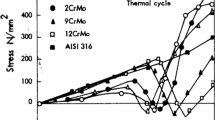Abstract
The high temperature gradients experienced during fusion welding lead to a local dilatation and metallurgical transformations that generate inhomogeneous plastic deformation, residual stresses and distortions in the welded parts which can affect the service life of the structures. To predict such residual stresses and distortions, finite element analysis is nowadays widely used. This work reports a 3D finite element model for welding simulation. The proposed model is based on semi coupled thermo-mechanical analysis using a double ellipsoidal model of heat source. Firstly, a disk heated in its central zone is investigated. Secondly the validation concerns the simulation of a fully 3D two pass butt weld. The idea in this work concerns the calibration of the heat source parameters with the help of the inverse analysis to improve the heat flow predictions. For the stress analysis, an annealing temperature is introduced to force the material to lose its hardening memory above a given temperature. The predicted residual stresses as well as the predicted distortions are found to be sensitive to the annealing temperature.
Similar content being viewed by others
References
Deng D, Murakawa H. Prediction of welding distortion and residual stress in a thin plate butt-welded joint [J]. Journal of Computational Materials Science, 2008, 43(2): 353–365.
Zain-Ul-Abdein M, Nelias D, Jullien J F, et al. Prediction of laser beam welding-induced distortions and residual stresses by numerical simulation for aeronautic application [J]. Journal of Materials Processing Technology, 2009, 209(6): 2907–2917.
Gilles P, El-Ahmar W, Jullien J F. Robustness analyses of numerical simulation of fusion welding NeT-TG1 application: Single weld-bead-on-plate [J]. International Journal of Pressure Vessels and Piping, 2009, 86(1): 3–12.
Satoh K, Ohnishi T. Transient thermal stresses of weld heat-affected zone by both-ends fixed bar analogy [J]. Transaction of Japan Welding Society, 1972, 3(1): 125–134.
Ueda Y, Yamakawa T. Thermal stress analysis of metal with temperature dependant mechanical properties [C]// Proceedings of the International Conference on Mechanical Behavior of Materials. Kyoto: [s.n.], 1971: 10–20.
Brickstad B, Josefson B L. A parametric study of residual stresses in multi-pass butt-welded stainless steel pipes [J]. International Journal of Pressure Vessels and Piping, 1998, 75(1): 11–25.
Sattari-Far I, Javadi Y. Influence of welding sequence on welding distortions in pipes [J]. International Journal of Pressure Vessels and Piping, 2008, 85(4): 265–274.
Wang Weibin, Shi Yaowu, Lei Yongping, et al. FEM simulation on microstructure of DC flash butt welding for an ultra-fine grain steel [J]. Journal of Materials Processing Technology, 2005, 161(3): 497–503.
Shi Yaowu, Chen Dong, Lei Yongping, et al. HAZ microstructure simulation in welding of a ultra fine grain steel [J]. Computational Materials Science, 2004, 31(3–4): 379–388.
Depradeux L, Jullien J F. Experimental and numerical simulation of thermomechanical phenomena during a TIG welding process [J]. Journal of Physics, 2004, 120: 697–704 (in France).
Goldak J, Chakravati A, Bibby M. A new finite element model for welding heat sources [J]. Metallurgical Transactions, 1984, 15B(2): 299–305.
Wohlfahrt H. Report on the experimental round robin tests on residual stresses [R]. Braunschweig, Germany: Institute of Joining and Welding, Technical University Braunschweig, 2006.
Author information
Authors and Affiliations
Corresponding author
Rights and permissions
About this article
Cite this article
Slimani, A., Rachik, M. High temperature indentation test to improve constitutive model for welding simulation. J. Shanghai Jiaotong Univ. (Sci.) 16, 286–290 (2011). https://doi.org/10.1007/s12204-011-1145-0
Received:
Published:
Issue Date:
DOI: https://doi.org/10.1007/s12204-011-1145-0



